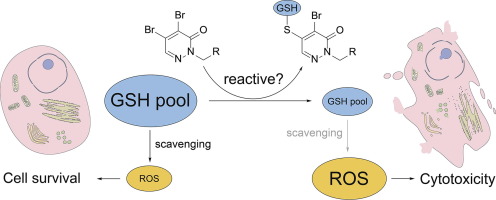Bioorganic & Medicinal Chemistry ( IF 3.5 ) Pub Date : 2017-11-04 , DOI: 10.1016/j.bmc.2017.11.009 Julian Wilke , Tatsuro Kawamura , Nobumoto Watanabe , Hiroyuki Osada , Slava Ziegler , Herbert Waldmann

|
Reactive oxygen species (ROS) play an essential role in the survival and progression of cancer. Moderate oxidative stress drives proliferation, whereas high levels of ROS induce cytotoxicity. Compared to cancer cells, healthy cells often exhibit lower levels of oxidative stress. Elevation of cellular ROS levels by small molecules could therefore induce cancer-specific cytotoxicity. We have employed high-throughput phenotypic screening to identify inducers of ROS accumulation. We found 4,5-dihalo-2-methylpyridazin-3-one (DHMP) and 2,3,4,5(6)-tetrachloro-6(5)-methylpyridine (TCMP) moieties to strongly deplete GSH, to cause ROS accumulation and to induce cell death. Small molecules containing these fragments will most likely share the same properties and should therefore be carefully considered in the development of bioactive molecules.
中文翻译:

识别通过谷胱甘肽耗竭诱导活性氧物种积累的细胞毒性,谷胱甘肽反应性部分
活性氧(ROS)在癌症的生存和发展中起着至关重要的作用。中等的氧化应激驱动增殖,而高水平的ROS则诱导细胞毒性。与癌细胞相比,健康细胞通常表现出较低水平的氧化应激。因此,小分子升高细胞内ROS的水平可以诱导癌症特异性的细胞毒性。我们采用了高通量表型筛选来识别ROS积累的诱导剂。我们发现4,5-二卤-2-甲基哒嗪-3-酮(DHMP)和2,3,4,5(6)-四氯-6(5)-甲基吡啶(TCMP)部分会严重消耗GSH,从而引起ROS积累并诱导细胞死亡。包含这些片段的小分子很可能具有相同的特性,因此在开发生物活性分子时应仔细考虑。



























 京公网安备 11010802027423号
京公网安备 11010802027423号